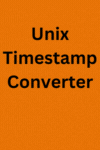A Unix Timestamp Converter is a practical online tool used to convert between Unix timestamps and human-readable date and time formats. Unix timestamps represent the number of seconds that have elapsed since a specific reference date and time, which is often referred to as the "Unix epoch." Here are some key points about the Unix Timestamp Converter tool:
Unix Timestamp Definition: A Unix timestamp, also known as a POSIX timestamp, is a numerical value that represents a precise point in time as the number of seconds since January 1, 1970, at 00:00:00 UTC (Coordinated Universal Time).
Numeric and Machine-Friendly: Unix timestamps are numeric and machine-readable, making them ideal for computer systems, programming, and database storage because they represent time in a consistent and unambiguous format.
Conversion to Human-Readable Format: The Unix Timestamp Converter performs the reverse operation, converting Unix timestamps into human-readable date and time formats that are easily understandable by people.
Date and Time Formatting: Users can typically choose from various date and time formatting options, such as different time zones, date formats (e.g., DD/MM/YYYY or MM/DD/YYYY), and 12-hour or 24-hour time formats.
Bidirectional Conversion: The tool allows users to input either a Unix timestamp or a specific date and time, and it provides the corresponding conversion. This flexibility is valuable for various applications.
Programming and Development: Developers and programmers use Unix timestamps in their applications and databases to manage time-related data, schedule events, and calculate time intervals with precision.
Data Migration: When migrating data between different systems or databases, Unix timestamps help maintain consistency in time data because they are not subject to timezone differences or date format variations.
Timestamp Generation: Unix Timestamp Converters can also generate Unix timestamps from human-readable dates and times, facilitating the storage and manipulation of time-related data in computer systems.
Historical and Future Dates: These tools can handle both past and future dates, allowing users to work with timestamps for events that have already occurred or are scheduled to happen.
Cross-Platform Compatibility: Unix timestamps are platform-independent and are widely used across various operating systems and programming languages, making them a universal choice for timestamp representation.
Debugging and Troubleshooting: Developers often use Unix timestamps for debugging and troubleshooting, as they provide an accurate record of when specific events or actions occurred in an application.
Historical Significance: The choice of January 1, 1970, as the Unix epoch has historical significance in computing and is often referred to as the "Unix epoch time."
In summary, a Unix Timestamp Converter is a valuable tool for converting Unix timestamps into human-readable date and time formats and vice versa. It serves a wide range of applications in programming, data management, data migration, debugging, and various other fields where precise timestamp representation is required.
Unix Timestamp Converter
Tags:
Unix Timestamp Converter

